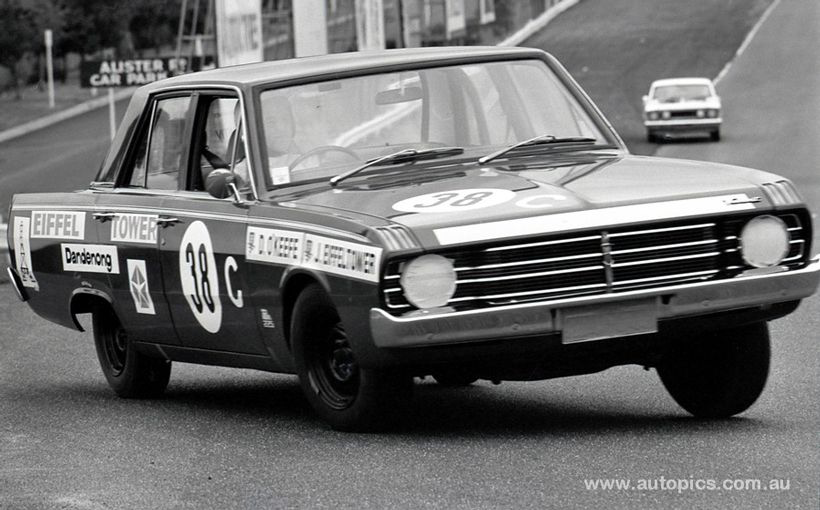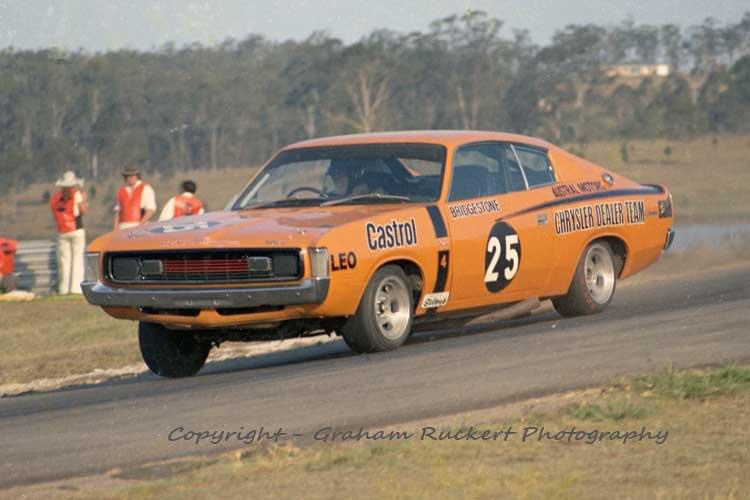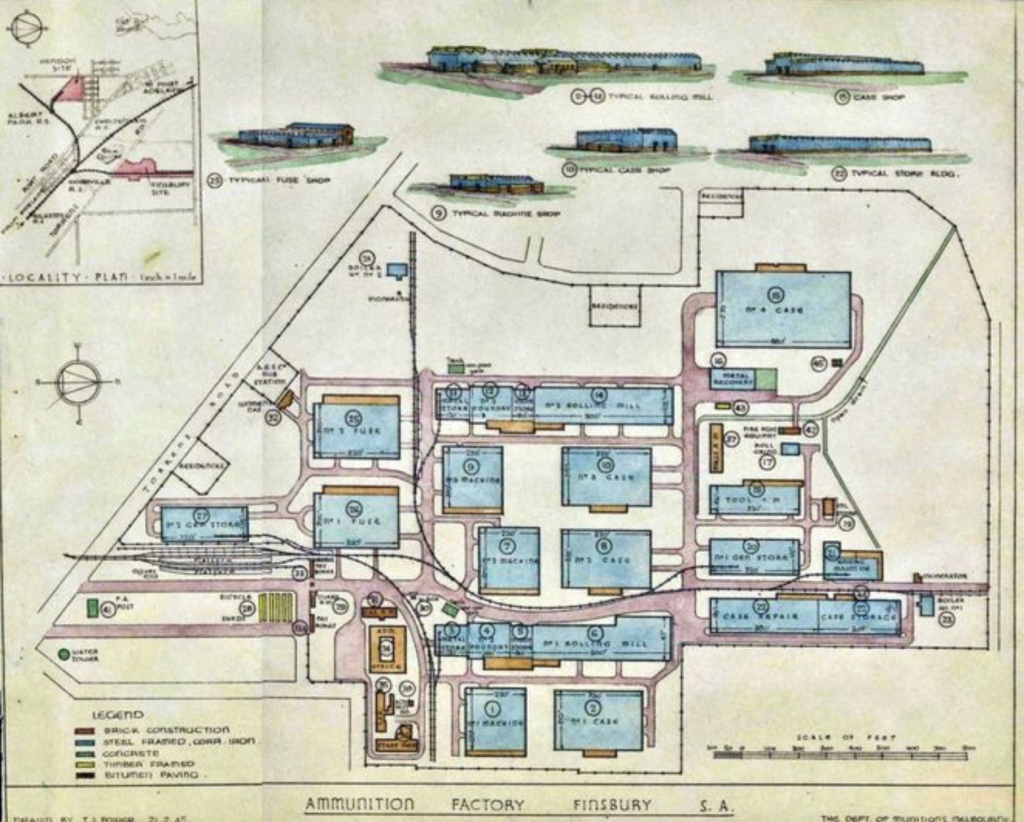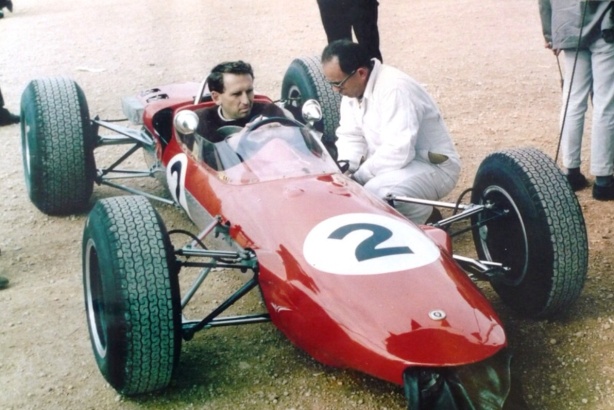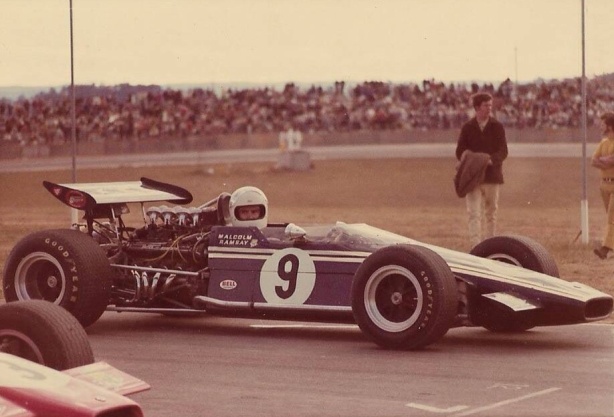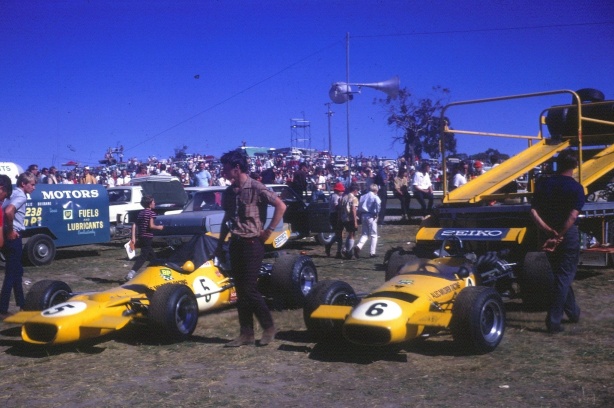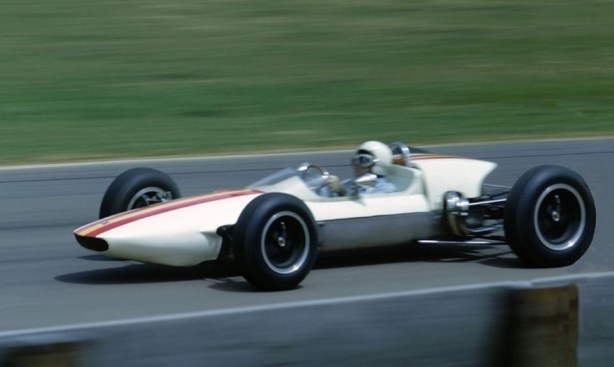
‘Joisus Harry and the boys look after me pretty well’ is perhaps the thought going through Peter Brock’s mind…
Harry and the Boys are the Holden Dealer Team- Harry Firth, Ian Tate, Bruce Nowacki and others who built and prepared the various Holdens that Australian Touring Car Greats, Peter Brock and Colin Bond raced.
The Birrana 272 Ford ANF2 car Peter is looking after at Hume Weir in 1973 was a Father and Son operation between Geoff and Peter Brock.
This wasn’t new to the touring car ace mind you- the Austin A30 Holden Sports Sedan which thrust the lad from Diamond Creek to fame was run in just that manner but by 1973 he had been a works driver for four years with all of the cossetting- and expectations which goes with it.
Brock has that ‘where the hell is Tatey’ look about him!? Mind you, he may have just spotted a pretty young filly at the burger stand and doing that instantaneous, nano-second process of visual assesssment we all do.
This is another of my whacky-dacky articles in that it started as a mid-week quickie but grew like topsy into a feature as I chased a few tangents- so its not as cohesive as some of my efforts. Its a bit of this and a bit of that, without being a whole lot of any one thing! Bare with me all the same.

Chunky lines of the new Birrana 272 in the Victorian Trophy Sandown paddock. Single top link and radius rod and bottom lower wishbone, coil spring/damper front suspension. Note the ‘stay’ between the front and rear front suspension mounts on the tub (Kym)
I’ve written about this important car- ‘272-002’ and Brocky’s time with it before.
The car is significant in the pantheon of Birranas in that that it was the first monocoque chassis Tony Alcock and Malcolm Ramsay built, as well as the first of a very successful run of Formula 2 and Formula 3 cars constructed by Birrana between 1972 and 1974- noting that production spluttered along into 1978 with a couple of additional cars built in the interim.
In 1972-3 ‘272-002’ was raced by Ramsay, 1971 AF2 Champ Henk Woelders once, Leo Geoghegan and Brock before passing into Bernie Zampatti’s hands in Perth- he still has it, so rather a nice jigger to own in every respect.
Some of the additional photographs of the car were taken in the Sandown paddock during the weekend Malcolm Ramsay contested the ‘Victorian Trophy’ Gold Star round in April, i’m wondering if this was the car’s race debut? Frank Matich won the race in his Matich A50 Repco, with Ramsay seventh- FM took the Gold Star that year, his only Australian Drivers Championship in a couple of decades at the pointy end of Australian motor racing in both sports cars and single-seaters.
For most of the year Malcolm raced the car in South Australia and Victoria- in addition to the Gold Star round at Sandown there was a ‘Repco (fiftieth) Birthday Series’ of five rounds at Calder contested by F3, F2 and F5000 cars- won by Kevin Bartlett’s Lola T300 Chev
Tony Alcock built the first Birrana- the Formula Ford F71-1 initially raced by John Goss and then David Mingay in the garage behind his house in the Sydney suburbs. By the time the later F72 FF’s were constructed he was in partnership with Malcolm Ramsay back in his native Adelaide.
Ramsay had previously raced Elfins and Alcock worked for Garrie Cooper both before and after a sojurn to Europe working for McLaren, Cooper, Cosworth and others- both were mates of Garrie, so in a way it must have felt strange competing with the much respected outfit from Conmurra Road Edwardstown.

Ramsey- is that him sitting on the tub? and 272 at cold, windy Calder during 1972- possibly the August meeting (oldracephotos.com.au/Hammond)
Mind you, the story is that Malcolm approached Garrie to build him a car with some design features he wanted, the ever accommodating Cooper was fully committed with the build of the 620 and MR5 series of cars at the time so really didn’t have the capacity to do a ‘one off’. So Mal decided to do it himself and approached Tony who was at a loose end at the time.

Ramsey, Victorian Trophy meeting, Sandown. Note the injected Lotus-Ford twin cam and its metering unit and breathers on the roll bar. Box FT200, shocks I think Armstrong- half moon steering wheel a distinctive Birrana feature- Frank Matich the other proponent of those in Oz (Kym)
The 272 was an utterly conventional racing car of the period but what was different from the Elfin 600- which had pretty much ruled the small-bore racing car roost in Australia since its 1968 Singapore GP win with Cooper at the wheel, was that the Birrana had a monocoque chassis whereas the 600- a winner in FF, F3, F2 and ANF1 guises was a spaceframe.
The 272 was beautifully built and quick out of the box- its performance when driven by Malcolm and ‘Dame Nellie Melba’ Geoghegan when Leo- the 1970 Gold Star Champion returned from short-lived single-seater retirement to drive the car later in 1972- and Birrana Australian Formula 2 Championship wins in 1973 (273) and 1974 (274). For the record, Birrana national F2 titles were also taken by Geoff Brabham (274) in 1975 and Graeme Crawford (273) in 1976.
Leo first raced the 272 in the Hordern Trophy Gold Star round at Warwick Farm in November only completing 3 laps before having gear lever problems. He raced the car again in the final Repco Birthday Series round at Calder in December and was convinced of the Birrana’s potential so signed to drive one of two works ‘273’ cars- the other raced by Ramsay in 1973.
The 273 took Alcock’s concepts further, the 274 further again with sales and wins aplenty- the full history of Birrana is for another time.

Leo Geoghegan gridding up for the Hordern Trophy at Warwick Farm late in 1972- that’s Garrie Coopers ELfin MR5 Repco to the left (S Geoghegan)

Brock squirts his 272 around Calder in early 1973 (G Moulds)
At the end of the 1972 season Birrana sold the car to Brock- who made it available for Malcolm Ramsay to race in the opening round of the 1973 championship at Hume Weir whilst Peter attended to Holden Dealer Team commitments.
Malcolm handed the car to Leo who had broken valve spring problems with his 273 Hart motor throughout the weekend including raceday. Geoghegan took a great and somewhat lucky win from the rear of the grid when Tony Stewart’s leading 273 had overheating dramas and had to reduce his pace- the plucky, quick Victorian was second and Chas Talbot, Elfin 600E Ford third.

Tony Stewart’s 273 from Geoghegan in the 272 with an the Skelton Bowin P6 on the outside- and Clive Millis’ abandoned 600B on the inside of the corner. A shame Stewart ceased racing this car after so few meetings- very fast driver, with support from Paul England should have, and could have gone far (ACY)

Geoghegan on Hume Weir’s Pit Straight, Birrana 272 1973- race run in tricky conditions including some rain, tailor made for the experienced Leo (ACY)
Brock raced the 272 for several more meetings before he too acquired a 273. Brock’s too short single-seater/Birrana sojurn is told here; https://primotipo.com/2018/05/07/brocks-birrana/ , with some Birrana history here; https://primotipo.com/2016/04/29/birrana-cars-and-the-1973-singapore-gp/
The 272 had a locally built 1.6 litre Lotus-Ford injected twin-cam engine- the Hart 416B variant de-rigeur in Australia from 1973 when all of the top-guns used these motors excluding Peter Brock.
Hewlands ubiquitous 5 speed FT200 gearbox was specified with lower wishbone bottom, top link and radius rod suspension at the front and single upper link, two lower links and twin radius rods deployed at the rear. Roll bars were used of course with cast Birrana uprights, wheels and steering rack finishing off a very nice package.

Wide, shallow, very rigid monocoque chassis, Varley battery beside the gearbox, locally built twin-cam by Peter Nightingale fitted with Globe injection (Kym)
Tailpiece: ‘Formula Birrana’ Adelaide International 7 October 1973…

(ACY)
Geoghegan and Ramsay in works 273’s sandwich the #18 Bob and Marj Brown owned 273 driven by Enno Buesselmann at Adelaide International in 1973, this race was won by Enno after Leo suffered a puncture.
Evolution of the 272 to 273 clear in this shot inclusive of period-typical ‘Tyrrell type’ enveloping nose.
Marque experts rate the 273 the pick of the Birranas with the 274 said to be not really a quicker car- as proved by the pace of Buesselmann’s car when driven by Bob Muir for the Browns in 1974 fitted with 274 nose and rear wing.
Geoghegan crushed the opposition in 1973- demonstrating amazing reliability, he finished all seven of the championships rounds, winning six of them- one in the 272, the balance in his 273. In a busy season, Geoghegan and Ramsay also raced the cars in Asia- this tour is covered in one of the articles linked above.

Bob Skelton, Bowin P6 Ford-Hart from Peter Brock, Birrana 273 Ford, Oran Park 1973 (ACY)
Afterthoughts…
Bob Skelton and the Bowin P6.
An interesting thing looking back at this F2 season is the performance of 1972 ‘Formula Ford Driver to Europe’ (DTE) winner Bob Skelton and his spaceframe chassis Birrana P6 Ford-Hart.
He was, despite being a far less experienced open-wheeler pilot than Leo who had been racing Tasman 2.5’s since 1966, and was racing wings and slicks for the first time- right up Geoghegan’s clacker on raw pace if not finishing record that season in a brand new, unsorted car. Two second placings from four of the seven rounds he finished was his best.
Let’s look a bit closer in terms of raw speed- at Hume Weir both Leo and Bob didn’t record a time- Tony Stewart started from pole on 45.4 seconds with no race times disclosed.
At Oran Park Geoghegan was on pole 42.3 secs, with BS right behind him on 42.5, Brock 44.2.
At Amaroo LG pole 48.7, BS again in second slot with 48.9, PB on 51.9- the last round of the series Brock contested.
At Surfers the cars raced within the Gold Star Glynn Scott Memorial Trophy F5000 race- Skelton bagged the F2 ‘pole’ with 1:9.5 from Leo on 1:10.4 with BS a tenth quicker in the race- the first occasion that happened that season.

Kneeling John Joyce fettles Skelton’s P6 at the Hume Weir opening round (ACY)

Symmons Plains grid with Geoghegan and Skelton on the front row. Chris Farrell, Dolphin 732 Ford (Brabham BT36 copy) and Enno Buesselmann Birrana 273 on row 2 with the distinctive #62 black Bowin P6 Hart of Bruce Allison on the right- to the left is Ian Fergusson’s Bowin P3 Ford. The #3 white 273 is Don Eubergang in the ex-Tony Stewart ‘273-007’- then an assortment of Elfin 600’s and a couple of Cheetah Toyota F3’s towards the rear- a very young John Bowe is in one the 600’s (ACY)
From Queensland the circus moved down South to Symmons Plains in Tasmania where Leo put the championship beyond doubt- both did 55.7 secs in practice. Skelton didn’t contest the final rounds in Adelaide or at Calder.
The conclusions to be drawn from the above are firstly that Skelton was a very quick driver- no shit Sherlock- he had won the DTE in 1972 apart from demonstrable pace in the sports and touring cars from whence he came. On raw pace the Bowin P6 was the equal of the Birrana 273 despite being brand new and untested prior to the seasons outset- and in the hands of a ‘wings and slicks’ novice.
It is a great shame Skelton’s single-seater career ended at this point, he deserved another crack at F2 or elevation to the F5000 Big League.

Bob got the babes, or TAA ‘hosties’ air- hostesses as they were before the days of political correctness! Bob Skelton taking a Ford Falcon XA GT Amaroo Park lap of honour after wrapping up the 1972 DTE. Slumming it on Fairlanes are second placed John Leffler and third place-man Bob Beasley- all raced Bowin P4A’s (unattributed)
In fact Skello’s ‘P6-119-72’ was the very first P6 built by John Joyce, completed, according to Bowin records, on 8 September 1972.
After winning the DTE in his trusty P4 Bowin Skelton raced the P6 once or twice in Oz to Formula Ford specifications- the P6 was an FF/F3/F2/Formula Atlantic spec car, four of the latter were exported to Canada in 1973/5, before shipping it to the UK and contesting the Snetterton Formula Ford Festival or ‘World Championship’.
He raced in the UK together with fellow Australians Larry Perkins (1971 DTE winner), John Leffler (1973 DTE winner) Buzz Buzaglo and Peter Finlay- the latter duo were at the time living in the UK and were ‘jets’ in British/Euro Formula Ford. How the Aussies fared is covered in this feature on Buzz I did yonks ago;
Buzz Buzaglo: Australian International Racing Driver and the Eternal Racing Story of Talent ,$,Luck…

Bob Skelton and ‘P6-119-72′ in the Snetterton paddock in late 1973, variable rate rear suspension linkages clear, alongside is Larry Perkins’ equally new Elfin 620. Both cars successful Formula Fords models for their respective makers (unattributed)
After shipment of the P6 back to Sydney the Bowin lads removed all the Formula Ford clobber- ‘Kent’ 1600 motor, Mk9 Hewland, brakes, wheels etc and added Hart 416B, FT200, wheels and calipers and wings and the rest and had the car ready- just, for the first 1973 F2 round at Hume Weir.

Hey presto, now I’m an F2! ‘P6-119-72’ in F2 guise with a nice shot of Skletons trick, schmick alloy, short-stroke Hart 416B twin-cam, circuit unknown (MRA)
These days the beautiful, radical P6/P8 Bowins with their progressive or ‘variable rate’ suspension are somewhat maligned on social media- it really is time I attack Bowin as a subject and address the facts armed with statistics in relation to the P6/P8- favourite racing cars of mine!
The colour photo above is Skelton’s P6 in front of Brock’s 273 at Oran Park during the ANF2 Championship round on 5 August- Geoghegan won from Brock and Skelton. Peter’s second place was the best of his two 1973 championship appearances, the final one was at Amaroo Park, also in outer Sydney, a fortnight later where he was sixth.
After that Brock ceased racing the 273- as quickly as he started it- the lure of touring cars was too great, Holden weren’t happy for Brock to race a Ford engined car and no doubt the self-running nature of the program was no fun- and by then not what was required to win in F2.
Mark Fogarty quoted Brock as saying ‘Brock was disillusioned by the formula…in 1972 F2 meant a simple chassis and twin-cam engine, but in 1973 monocoque chassis and supertrick Hart motors were the rule if you wanted to be competitive’. ‘Brock, in between HDT commitments, struggled on…until it became apparent that he was banging his head against the wall without a Hart…’

PB was second in the ’73 Oran Park round, here in his new Birrana 273- unsponsored. Odd the lack of support for the 1972 Bathurst winner (ACY)
Peter Brock and single-seaters.
The opening photograph in this article aroused plenty of Facebook chatter about Brock’s prowess as an open-wheeler driver- the fact is of course we can never be definitive about Peter’s capabilities because he simply didn’t stick at it for long enough to make a determination.
He had good equipment in both the 272 and 273 chassis but the cars were not, as noted above, fitted with the Ford-Hart 416B engine. Good for about 205 bhp, these motors were 15-20 bhp, depending upon accounts, more powerful than the best of the local twin-cams.
Most of the quicks in 1973 had them including Geoghegan, Ramsay, Buesselmann, Stewart, Skelton and Bruce Allison (Bowin P6- a sixth and a fourth Bruce’s best in a car he loathed- the 274 he raced in 1974 was much more to his taste and his results reflected it!) Winter (Mildren Yellow Submarine).
What we do know is that Brock was quick in anything and everything- in machines as diverse as the Austin A30 Holden, Touring Cars of god knows how many number from Holden Monaro GTS350 to V8 Supercars, rally and rallycross cars, Bob Jane’s 600 bhp plus Chevy Monza Sports Sedan to the Group C Porsche 956 Prototype he shared with Larry Perkins at Silverstone and Le Mans in 1984. In all of these cars and disciplines Brock was a winner or at least very competitive.
By all accounts- and so many of us watched him for four decades, so we all have a view- Brock was a versatile, adaptable, mechanically sympathetic, consistently fast and aggressive but thoughtful, analytical racer of elite international level and standing.
That does not mean he would have been an ace in single-seaters, but on balance, my ‘I reckon’ is that he would have been at least the equal of the best Oz resident open-wheeler guys had he focused in part or exclusively in the rarefied end of the sport…
Let the debate begin!

Brock, in Birrana overalls bending Ian Tate’s ear (i think) at Calder in 1973 (unattributed)
Photo and other Credits…
Dean Oliver, Kym, Glenn Moulds, ACY- Australian Competition Yearbook, Mark Fogarty in Australian Motor Racing Annual, Racing Car News, oldracingcars.com, Shaun Geoghegan
Etcetera…

Brian Hart and Hart engines article; https://primotipo.com/2016/10/21/hart-attack/

Brock, Birrana 272 Ford, Calder 1973 (AMRA)
Tailpiece 2…Leo G and Birrana the dominant 1973/4 F2 combo…

(AMY)
I’ve taken a few twists and turns in this article but let’s not lose track of Leo’s superb driving in 1973- Birrana gave him a brilliantly designed, built and prepared car that year and in 1974which he put to very good effect.
A shame was that he didn’t switch into F5000 after his 1970 Gold Star win aboard a Lotus 59B Waggott- Lord knows we needed a few more cars on the grid, but it was great, having read so much about Leo before I first went to a race meeting, to be able too see so many of his F2 races in 1973 and 1974! He was ‘the goods’.
RIP Leo Geoghegan.
Finito…




